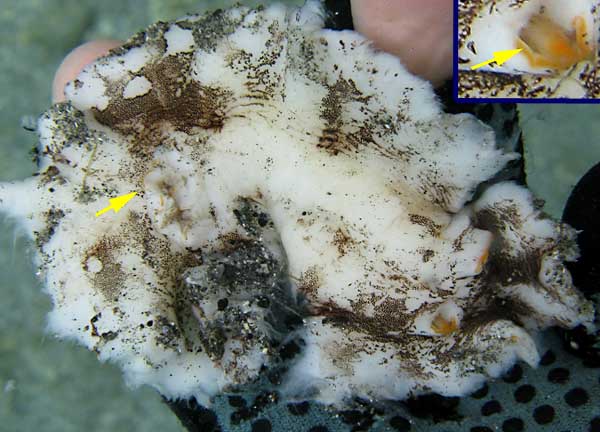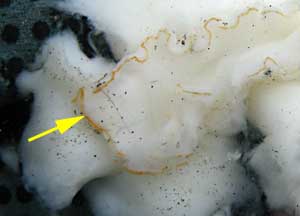This species has been observed on Reunion, Mayotte, Mauritius and Madagascar Islands
Species characteristics : The background colour of the living animals is white or pale cream.There are dark, large, irregular markings of brown, purple, or grey on the dorsum. These markings vary in distribution, often covering most of the dorsum. They are composed of a number of small dark spots, which are more densely arranged in several areas. The mantle margin, the foot and the rhinophoral and branchial sheaths are edged by a thin orange or yellow line. The rhinophores are yellowish, often with darker orange tips.
|

|
|
| Showing species characteristics... | Photo Philibert Bidgrain Mayotte, Mtsanga Guini, less 1 m, 3 August 2010, size : 50 mm |
|
Remarks :
Identification confirmed by Angel Valdès
In some specimens from our area, the edge of the mantle, foot, rhinophore pockets and gill pockets are orange or yellow, but in many specimens they are not
Synonymous : (according Worms)
- Platydoris eurychlamys, Bergh, 1877
- Platydoris noumeae, Risbec, 1928
Bibliographic data :
This species, with P. formosa, P. striata, P. cruenta and P. cinerobranchia form a group of very similar species.
Remark : Dorgan, K.M., A. Valdés & T.M. Gosliner. 2002 consider that P. cruenta ( Quoy & Gaimard, 1832 ) and P. striata (Kelaart, 1858) are regarded as synonyms.
P. scabra
P.cruenta
P.cinerobranchiata
Localisation
Tropical Indo-West Pacific
Tropical Indo-West Pacific
Tropical West Pacific
Tropical Indo-West Pacific
Solomon Islands
Mantle coloration
Brown spotted
with red patchesBrown spotted
without red patchesBrown lined
with red patches
Brown lined
without red patchesReddish, or orange patches and no brown specks or lines.
Rhinophore coloration
They are uniformly red, with the tips somewhat lighter
They are yellowish, often with darker orange tips.
They have a dark brown clavus with white flecks on the lamellae
They are dark red or brown
They are dark red or brown
Underside of the mantle and foot
The underside is white and has many large, bright orange red spots (not always easily visible). These spots are larger and densely concentrated near the foot, where some of them can be fused together
The underside of the mantle is dirty white and there are some brown speckles on the side of the foot.
The underside of the mantle is white with brown lines near the foot, and scattered red patches. The sole of the foot can also have brown lines
The underside of the mantle is white without red patches
The underside of the mantle is white with red patches
The brown patches on the mantle are arranged more or less symmetrically either side of the midline.
The gill is composed of five to six tripinnate branchial leaves. The branchial leaves are white with irregular dark lines on the rachis of the lamellae.
The opening of the branchial sheath has five to six lobes, with the anterior and posterior ones being larger than the others.
The perfoliate rhinophores have 37 lamellae in one specimen examined. They are yellowish, often with darker orange tips.
The underside of the mantle is dirty white and there are some brown speckles on the side of the foot.
Species of Platydoris are easily recognized by their flattened, normally rigid (or coriaceous) body. This genus is also characterized by the dorsum covered with very small caryophyllidia and generally a lobate branchial sheath
It probably feeds on siliceous sponges
Found on shallow water under coral heads. Often crawling in the open during the night
Breeds from May to september in Red Sea, laying an orange yellow ribbon in a spiral approximatively 100 mm across (Soliman, 1978)
References :
Bill Rudman Seaslug site : Sea Slug Forum : Platydoris scabra
Nudipixel Platydoris scabra
Publications :
Dorgan, K.M., A. Valdés & T.M. Gosliner. 2002. Phylogenetic systematics of the genus Platydoris (Mollusca, Nudibranchia, Doridoidea) with descriptions of six new species. Zoologica Scripta. 31(3): 271-319.
Soliman, G. N. 1978 The redescription, reproductive and development of the Dorid Nudibranch Platydoris csabra (Cuvier) from the northwestern Red Sea. Journal of Molluscan Studies 44 (2): 151-165.
Other photos of Platydoris scabra :
 |
Philibert Bidgrain
 The mantle margin, the foot (a) and the rhinophoral (b) and branchial (d) sheaths are edged by a thin orange or yellow line. The rhinophores are yellowish, often with darker orange tips (c). |
The gill is composed of five to six tripinnate branchial leaves. The branchial leaves are white with irregular dark lines (e) on the rachis of the lamellae. The opening of the branchial sheath has five to six lobes, with the anterior and posterior ones being larger than the others.
|
 |
Olivier Police Mayotte, Petite-Terre, less 1 m, 25 December 2010, size : 100 mm |
|
A specimen without orange margin ion the mantle, the foot and the rhinophoral and branchial sheaths 
|

|
 |
Olivier Police Mayotte, Petite-Terre, less 1 m, 25 December 2010, size : 100 mm A second specimen without orange margin ion the mantle, the foot and the rhinophoral and branchial sheaths The brown patches on the mantle are arranged more or less symmetrically either side of the midline. |
Christophe Cadet Reunion, Etang salé, less 1 m, 9 January, size : 35-40 mm A dead specimen... With the characteristic orange border on the rhinophores, gills and foot...
|
 |
More photos from Indian Ocean
Madagascar, Platydoris scabra with pale orange margin, at Andavadoaka, by Alain Barrère
Mayotte, Platydoris scabra with orange margin, at Tanaraki, by Fabrice Schubert
Mauritius, Platydoris scabra, at Pointe d'Esny, by Geoffrey Summers
